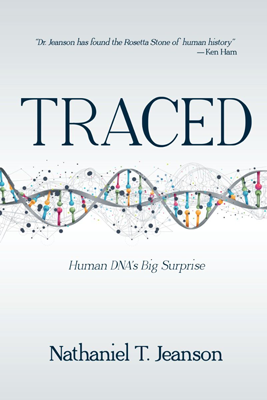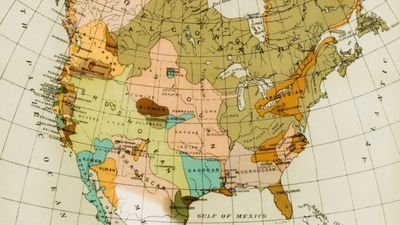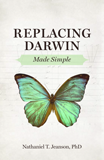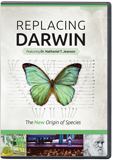Traced: Human DNA’s Big Surprise
Secrets of the New Rosetta Stone

My new book, Traced: Human DNA’s Big Surprise
Several years ago, I advanced an audacious thesis: that creationists are replacing Darwin’s ideas with newer, better explanations for the origin of species.1 A few months after Replacing Darwin was published, scientific successes further supported this thesis.2 Now, four and one-half years into evaluating this claim, we’ve reached another milestone.
On the question of human origins and human history, creationist ideas are performing even better than expected. Creationists are now making major scientific discoveries. My new book, Traced: Human DNA’s Big Surprise, describes one of the biggest and newest of these discoveries—one that is adding not just new chapters but new volumes to how we understand our past.
I describe seven of these volumes below.
1. The History of Peoples
What happened to the ancient Egyptians? When their civilization fell at the hands of Asian and European invaders, what happened to the Egyptian people? We could ask similar questions of any of the world’s other great civilizations: When Rome fell in the AD 400s, what happened to the Roman people? Are modern Italians their descendants? What about the ancient Persians? Does their family line include modern Iranians?
Within the last four years, creationists have uncovered a new Rosetta Stone of human history: a DNA-based, generation-by-generation family tree for global humanity.
Within the last four years, creationists have uncovered a new Rosetta Stone of human history: a DNA-based, generation-by-generation family tree for global humanity. This tree traces the rises and falls of the peoples of the world’s great civilizations. In Traced: Human DNA’s Big Surprise, I walk the reader through the history of the people from seven of the world’s major civilizations.
In doing so, we end up uncovering the story of the people of the whole world.
2. “Prehistory”
Large swaths of human existence before the arrival of written language to a particular area have been consigned to “prehistory.” The Americas before the arrival of Columbus, pre-colonial Africa, the pre-colonial Pacific, and early Southeast Asia all have their own mysteries.
We know various facts about their ways of life—religious practices, weapons, houses, diets, and everything having to do with the present. But how did this way of life develop over thousands of years? From whom did it arise?
Fast-forward to 2018–2019, when creationists first begin to shine a light on the existence of the new Rosetta Stone of human history. This DNA-based tree reveals that the family tree of today’s Native Americans broke away from the family trees in Central Asia at least twice—once in the AD 300s to 600s and again around AD 1000. In other words, today’s Native Americans are descendants of at least two groups of migrants from Central Asia: One group arrived in the centuries after Christ, another about a millennium after Christ.
Now combine these observations with the archaeological record of the Americas: Mayan origins trace back to the 400s BC, and the Olmecs go back even farther—they birthed a cradle of civilization. Yet we don’t find a genealogical heritage this ancient among modern Native Americans. It seems that the people who arrived in the AD 300s to 600s, and again around AD 1000, replaced whoever was here first.
The new Rosetta Stone reveals that the pre-Columbian Americas was a dynamic place, with a history as dynamic as that for Europe and the rest of the world.
3. Found: The Genealogical Line of Abraham and Noah
Thanks to the genealogies of Genesis 10 and 11, the Israelites can trace their heritage back to Noah himself via Noah’s son Shem. These chapters record a precise, specific number of generations from the flood down to Abraham.* The DNA-based tree contains a near-exact match to this family tree structure.
Furthermore, all the nations of the world trace their ancestry to the names listed in Genesis 10 (i.e., see the Tower of Babel incident recorded in Genesis 11:1–9). For around half of the men in Genesis 10, Scripture provides explicit commentary on their fates. On the rest, Scripture is silent, which itself is a clue to their fates.3 Long story short, this biblical data on the fates of the nations also finds a clear echo in the DNA-based tree.
Naturally, these results imply that we should find Noah and his three sons at the base of the DNA-based tree. We do.
Naturally, these results imply that we should find Noah and his three sons at the base of the DNA-based tree. We do.
4. You Hold Secrets to the Past
Genesis 10 lists around 70 names, and I think these 70 names represent the 70 ethno-linguistic groups that separated at the Tower of Babel (see Genesis 11:1–9). However, the DNA-based tree does not show 70 lineages in the most ancient parts of the tree. Why not?
In short, the number of branches on any family tree corresponds to the population size at specific points in time in a family’s history. This is true for individual families, and if we had access to the family tree for all of the people on earth, it would be true for this tree as well; the global family tree would have nearly eight billion branches.
Right now, full DNA4 information has been acquired from only tens of thousands of people, not billions. Hence, the DNA-based tree has only thousands of branches at present. But this will change as we sample more DNA from more people. And as we sample more DNA, we will likely discover more branches, not just at the tips of the tree but also in its deepest parts—the parts that depict ancient history.
5. The “Races” Have Changed Multiples Times in Human History
Basic genetics has long taught us that change from one set of physical features (commonly called “racial” features) to another can happen in just a few generations. In theory, the “races” could have changed multiple times in human history. The DNA-based tree reveals that they did.
For example, some light-skinned Scandinavians are descendants of olive-skinned Arabs who ruled the Middle East in the Middle Ages. These Arab ancestors were themselves descended from dark-skinned Nubians (i.e., the ancient Sudanese). And these dark-skinned Nubians were connected to ancient Egypt.
As another example, some dark-skinned sub-Saharan Africans had olive-skinned Central Asian ancestors who overthrew the Roman empire in the AD 400s. And on and on the examples go. Yes, you might have some big surprises in your own family tree—and connections to ancient civilizations and ancient peoples that you never thought possible.
6. Indigenous History and Missions
Many indigenous groups have their own accounts of their origins and history. What should we make of accounts like these? In the modern academic world, many indigenous narratives have been dismissed as fanciful or mythical. The icy posture towards these narratives is slowly beginning to thaw, but widespread neglect persists.
Surprisingly, the new Rosetta Stone is confirming the veracity of an increasing number of indigenous histories.
Surprisingly, the new Rosetta Stone is confirming the veracity of an increasing number of indigenous histories. From the oral history of the Bantu peoples of sub-Saharan Africa to the traditional origin (from Israelites!) of the Pashtuns of Afghanistan to the Karen people of Burma/Myanmar to the migration account of the Choctaw of North America, the DNA-based tree lines up with many native traditions.
But there’s more. Because we find Noah and his three sons at the base of this DNA-based tree, we now have the ability to connect the history of every single people group on earth back to one of these three sons and to specific ancestors listed in Genesis 10. I can now tell you that most Bantu people arose from Ham’s line, likely via his son Cush. Today’s Native Americans arose from a son of Joktan, who was the great-great-grandson of Shem. And the list goes on.
Consider the immediate relevance that this has to Christian missions. I spoke to one retired Bible translator about these results, and he cited the dark-skinned people of New Guinea as a special example. In his view, the DNA-based tree could now allow these people to see a very organic connection to where their history started in Scripture. He also said that this sort of connection would aid in their recognition of Scripture as “not just a white man’s book.” For some peoples, I can already predict where their branches will show up.
7. Turning the Tables on the Creation/Evolution Debate
This last sentence has more significance than first meets the eye. For decades, creationists have been defending the Bible from the attacks of mainstream science. Yet the mainstream scientific community has demanded something else:
Creation-science isn’t science at all, nor have creation scientists managed to come up with even a single intellectually compelling, scientifically testable statement about the natural world. At least ninety-five percent of all of their reams of privately published books and pamphlets are devoted to an attack on conventional science. [Creationists] pose no testable hypotheses and make no predictions or observations worthy of the name.5 [emphasis added]
The essential characteristics of science are:
(1) It is guided by natural law;
(2) It has to be explanatory by reference to natural law;
(3) It is testable against the empirical world;
(4) Its conclusions are tentative, i.e., are not necessarily the final word; and
(5) It is falsifiable.
Creation science . . . fails to meet these essential characteristics.6 [emphasis added]
The most important feature of scientific hypotheses is that they are testable. . . . Scientists cannot test the hypothesis that an omnipotent God exists, or that He created anything, because we do not know what consistent patterns these hypotheses might predict.7 [italics theirs; bold emphasis added]
What do evolutionists and legal experts mean when they insist that creation science be testable and falsifiable and that creation science must make predictions? Consider the science of something less controversial: gravity. In theory, gravity can be tested and disproven—or falsified—at any time. Just pick up an object with your hand and then release it. Does it fall back to earth? This is what gravity predicts. If you pick up a rock, release your grip, and then the rock levitates, we have reason to question the validity of gravity. But this is not our experience. Time and again, gravity operates according to the predictions that naturally flow from it. Gravity is, therefore, a well-established scientific idea.
In contrast, the evolutionists say creation science does not make predictions that can be tested and, in theory, disproven/falsified. Sure, creationists come up with plenty of problems with evolution. But what predictions do these criticisms make? For example, in the field of biology, how does identifying a flaw in evolution-by-natural-selection help explain when, how, where, and from whom species arose? From an anti-evolutionary and pro-design perspective, how many species should form this year? Where should they form? Which specific species will form new ones? These are the types of predictions that evolutionists insist on seeing from the creation science community.
As I alluded to at the beginning of this article, this mainstream complaint about creation science took a significant hit in October of 2017—when my book Replacing Darwin was released. In the book, I laid out numerous, specific, testable, falsifiable predictions about the origin of species. I also spelled out a very specific prediction about human origins and the genetics of human origins:
My model suggests that the history of civilization can be read off of the nuclear DNA differences [i.e., the DNA in a specific part of our cells] among the peoples of the globe—and on a timescale consistent with the YEC [young-earth creation] model. The Y chromosome differences [i.e., DNA differences in male-inherited DNA] among modern humans represent, in theory, the first type of nuclear DNA signature of the history of civilization.8
Put simply, if the history of humans is only a few thousand years old, as the Bible indicates, then this should be abundantly obvious in our DNA. My new book, Traced: Human DNA’s Big Surprise, shows that the echoes of civilizations are stamped all throughout our DNA.
Traced meets the gold standard of what defines science, and the research in Traced exceeds the demands that evolutionists have made of creationists for decades.
In other words, Traced marks the dawn of a new era in creation science. It fulfills creationist predictions made several years ago. It also contains even more predictions of its own—an entire research program that continues as you read this article, which I referenced at the end of the previous section. Traced meets the gold standard of what defines science, and the research in Traced exceeds the demands that evolutionists have made of creationists for decades.
I’ll put it more bluntly: Traced does very little in the way of defending the authority of the Bible—because Traced doesn’t play defense. Instead, Traced puts biblical authority on offense.
Let the major scientific discoveries by creationists keep coming.
Footnotes
- Nathaniel Jeanson, Replacing Darwin: The New Origin of Species (Green Forest, AR: Master Books, 2017).
- Nathaniel Jeanson, “A Bombshell for Replacing Darwin?”, March 1, 2018, https://answersingenesis.org/evidence-against-evolution/bombshell-replacing-darwin/; Nathaniel Jeanson, “A Second Bombshell for Replacing Darwin?” March 9, 2018, https://answersingenesis.org/evidence-against-evolution/second-bombshell-replacing-darwin/.
- The logic is as follows: (1) Scripture is silent on many geographic regions of the globe (i.e., China, India, New Guinea, Australia, the Americas, etc.). Yes, the global statements of Scripture apply to these regions, but in terms of specific direct mention, we don’t find them in the Bible. (2) Scripture is also silent on the fates of many of the men in Genesis 10. (3) Therefore, the men in Genesis 10 (on whose fate Scripture is silent) naturally become candidates for settling these geographic regions (which receive no direct mention in Scripture). The DNA-based tree matches these scripturally derived expectations.
- I’m referring specifically to the male-inherited DNA, the Y chromosome.
- N. Eldredge, The Monkey Business: A Scientist Looks at Creationism (New York: Washington Square Press, 1982), 80, 138.
- McLean v. Arkansas Board of Education, 1982, https://law.justia.com/cases/federal/district-courts/FSupp/529/1255/2354824/.
- D. Futuyma and M. Kirkpatrick, Evolution (Sunderland, MA: Sinauer Associates, 2017), 578.
- Jeanson, Replacing Darwin, 229–230.
Recommended Resources

Answers in Genesis is an apologetics ministry, dedicated to helping Christians defend their faith and proclaim the good news of Jesus Christ.
- Customer Service 800.778.3390
- Available Monday–Friday | 9 AM–5 PM ET
- © 2025 Answers in Genesis








